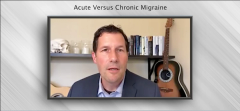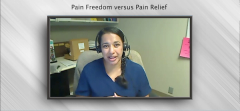
Therapy Assessment: Pain Relief & Onset Monitorization
Episodes in this series

A discussion on how to measure pain relief in acute migraine treatment and how to monitor the onset of action of therapy.
Wade M. Cooper, DO: When it comes to how to measure relief in migraine, the best question we can ask is, “How well controlled do you feel your migraine is?” A lot of times, patients may say their headache is reduced. They may say they’re feeling a bit better, but they may not be satisfied with that answer.
One of the things I like to ask about if I’m assessing someone for their headache effectiveness is, “How many times in the last month have you been disabled or incapacitated from an acute migraine?” Meaning how many times they have to stop their plans from their work, their family, or their social events that they have going on. Incapacity, taking people out of their daily lives, is a huge issue for people with migraine.
When we ask about onset of action, that’s always a really sticky question, because we first have to expect and hope that our patients are going to use therapies right when their symptoms start. There is some excellent evidence out there that medications like triptans really need to be taken in the beginning phase of someone’s acute headache. A lot of this is scientific. We know that triptans and some of the gepant class medicines work on the lining of the brain, where the meningeal pain through the trigeminal fibers is sent deep into the brain itself. If you wait too long, and that signal from the lining of the brain becomes amplified and it gets reactivated back into the brain stem itself, you’ve lost your opportunity for medications that work in the periphery to have their experience.
We need our patients to take their medications early in many situations. We also asked them, “When you take your medicine, how long does it take before you feel like it’s effective?” This number will vary dramatically. Some patients will say, “I can feel the benefits of my acute therapy within 10 to 15 minutes.” Some people say it can take 4 to 6 hours. Some of my patients even say, “It doesn’t affect me until the next day.” What they mean by that is, what would have been a 3-day migraine attack has been shortened to 1 day, but that’s still 1 full day where they’re being pummeled by migraine—not just the headache component, but the nausea, the light and sound sensitivity, and important to my patients, the impact in their quality of life.
If you’re asking, “Do patients wait? Do they not use their medicines appropriately?” The answer is absolutely. A lot of my patients have to ration their acute therapy. They know that if they’re going to have 15 days of headache per month, and they’re told they can use it only 2 or 3 days a week, they’ve got to save it for when they think a bad headache is coming. Some of my patients save it for when they can’t afford to be incapacitated. If they’ve got a best friend’s wedding coming up on the weekend, they may not use their acute therapy on weekdays. They’ve got to save it for that wedding, even if that means that they go without treating a headache, even when they possibly could.
The other thing that people do is they tend to wait. Part of migraine is a sterile inflammatory response in the lining of the brain, and part of that gives people this confusional element in which they’re not quite themselves. We call this the prodrome, where people don’t have the same awareness. Many times, even if you do psychological testing, people tend to do poorly in the prodrome phase of their migraine, even when they score normally outside their migraine attack. But because of this prodrome, people take awhile to connect the dots that they’re going into a migraine.
Sometimes it means their spouse has to say, “You’re going into a migraine, so take your medicine.” Or someone at work will notice they’re acting funny and say, “I think something is not right with you.” Then the light bulb goes on: “Aha, I might be having a migraine symptom.” But as they wait to take their medications, or they skip taking their medications because they’re afraid of adverse effects, or if they don’t have any faith that it’s going to be effective, that may set them up for bad consequences. More severity of migraine, longer duration of migraine, incomplete response to their therapy.
Newsletter
Keep your finger on the pulse of neurology—subscribe to NeurologyLive for expert interviews, new data, and breakthrough treatment updates.









































